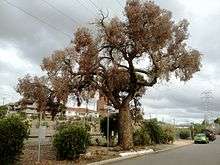Eucalyptus todtiana
| Coastal Blackbutt | |
|---|---|
 | |
| A remnant Coastal blackbutt in Victoria Park, Western Australia | |
| Scientific classification | |
| Kingdom: | Plantae |
| (unranked): | Angiosperms |
| (unranked): | Eudicots |
| (unranked): | Rosids |
| Order: | Myrtales |
| Family: | Myrtaceae |
| Genus: | Eucalyptus |
| Species: | E. todtiana |
| Binomial name | |
| Eucalyptus todtiana F.Muell. | |
Eucalyptus todtiana is a species of tree native to south-western Australia.
Common names include Blackbutt, Coastal Blackbutt and Pricklybark.[1]
Description
E. todtiana grows to about 15 metres, either as a tree (with single trunk) or as a mallee (i.e. with multiple trunks).[2] It has a weeping habit and rough fibrous grey/brown bark with tough, fine fibres.[3]
It produces cream and white flowers from January to April.
Distribution and habitat
The Eucalyptus todtiana generally grows near the crests of low sandy rises in the Bassendean sands, sometimes over laterite and more mostly with Jarrah and Marri in the west. Also over Banksia and Sheoak in the east.[3] It prefers light, well-drained soils in an open, sunny position.[3]
Distribution is mainly between Perth and Dongara in the Southwest Botanical Province, Avon Wheatbelt, Geraldton Sandplains, Jarrah Forest and the Swan Coastal Plain.[2]


Due to diminishing remnant bushlands within the Perth metropolitan area, individual trees are becoming less common. One specimen on Kitchener Road, Victoria Park (pictured) adjacent to the Armadale railway line in the Town of Victoria Park, was listed on the Council's Significant Tree List, but has since died and been cut down.
Taxonomy
It was first described by Ferdinand von Mueller in 1882, based on specimens collected by him from sandy ridges near the Greenough and Arrowsmith Rivers, and also specimens collected by John Forrest from near the Moore River. The specific name honours Emil Todt, a botanical artist who drew some of the plates for Mueller's Atlas of Eucalypts.[4] It has had an uneventful taxonomic history, with no subspecies or varieties, and no synonyms.[5] In the most recent infrageneric classification, it is placed in E. subg. Eucalyptus, sect. Hesperia, ser. Todtianae.[6]
Cultivation
E. todtiana is not often grown in cultivation. It grows rapidly as a sapling if planted in an open position, but as an adult it grows slowly and flowers profusely.[7]
References
- ↑ "Australian Plant Common Name Database". Australian National Botanic Gardens. Retrieved 2007-10-23.
- 1 2 "Eucalyptus todtiana". FloraBase. Western Australian Government Department of Parks and Wildlife.
- 1 2 3 "Remnant Vegetation Plan" (PDF). Town of Victoria Park. August 2004. Retrieved 2007-10-23.
- ↑ Hall, Norman (1978). Botanists of the Eucalypts. Australia: Commonwealth Scientific and Industrial Research Organisation. ISBN 0-643-00271-5.
- ↑ "Eucalyptus todtiana F.Muell.". Australian Plant Name Index (APNI), IBIS database. Centre for Plant Biodiversity Research, Australian Government.
- ↑ "Series Todtianae". EucaLink. Retrieved 2007-10-23.
- ↑ Powell, Robert (1990). Leaf & Branch. Department of Conservation and Land Management. ISBN 0-7309-3916-2.
See also
- Eucalyptus pilularis known as blackbutt in southeastern Australia
- Eucalyptus patens known as blackbutt in southwestern Australia
External links
- "Eucalyptus todtiana Pricklybark ; Coastal blackbutt". Kensington Bushland Reserve - Town of Victoria Park. Retrieved 2007-10-23.